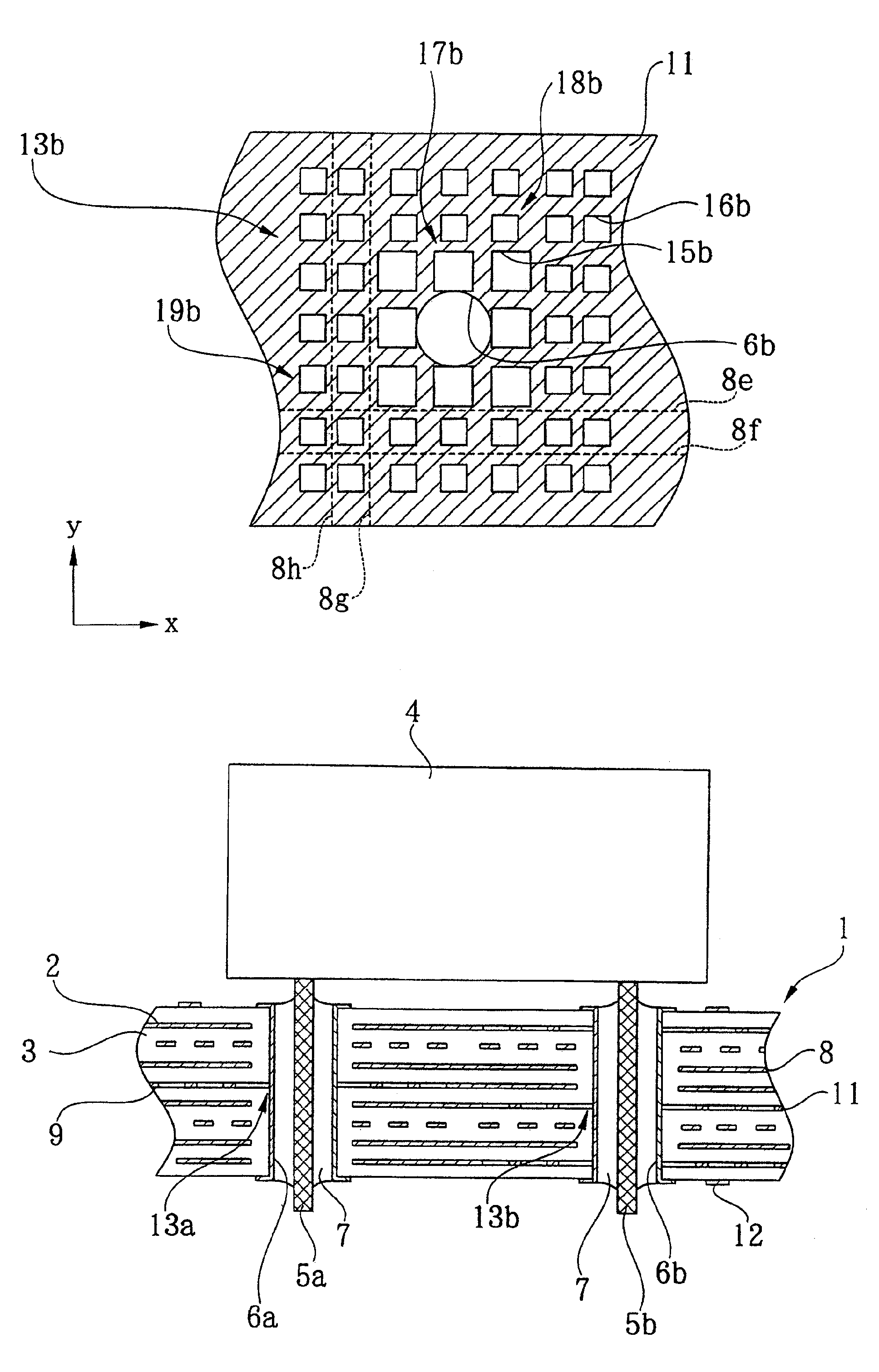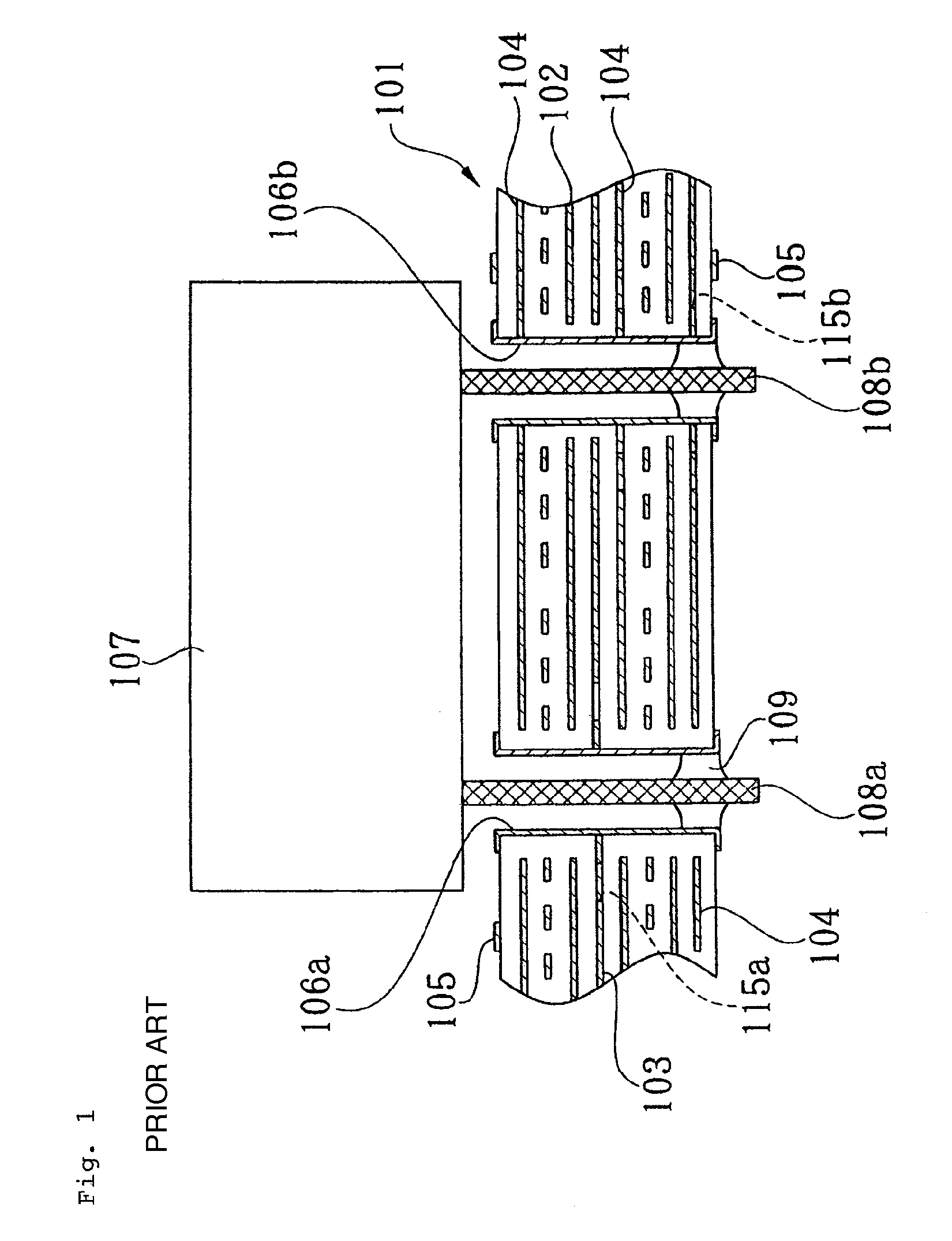Printed wiring board including a thermal land for supressing heat dissipation
a technology of printed wiring board and thermal land, which is applied in the direction of printed circuit details, circuit thermal arrangement, printed circuit, etc., can solve the problems of reducing connection reliability, adversely affecting connection reliability, and degrading of soldering finished condition, so as to reduce the heat capacity of through holes and suppress heat diffusion. , the effect of good finished condition
- Summary
- Abstract
- Description
- Claims
- Application Information
AI Technical Summary
Benefits of technology
Problems solved by technology
Method used
Image
Examples
exemplary embodiment 1
[0071]FIG. 4 is a sectional view showing the configuration of a thermal land formed in the ground layer of the multilayer printed wiring of board of a first exemplary embodiment. FIG. 5 is a sectional view showing the configuration of a thermal land formed in a power supply layer of the same multilayer printed wiring board. FIG. 6 is a sectional view to show the configuration of the same multilayer printed wiring board.
[0072]Multilayer printed wiring board 1 of this example is installed in electronic equipment such as computers and communication apparatuses, and has a multilayer structure in which a plurality of conductive layers 2 and insulation layers 3 are alternately laminated as shown in FIG. 6. Further, multilayer printed wiring board 1 includes a plurality of through holes 6a, 6b, . . . . The plurality of through holes 6a, 6b, . . . penetrate a plurality of conductive layers 2 and insulation layers 3 from the front face to the rear face, are inserted with lead wirings 5a, 5b,...
exemplary embodiment 2
[0119]FIG. 7 is a sectional view showing the configuration of the multilayer printed wiring board of a second exemplary embodiment.
[0120]The feature of the present exemplary embodiment that is different from the above described first exemplary embodiment is that it is applied to the mounting of surface mounted devices (SMD) in place of through-hole mounted devices.
[0121]Since the configurations other than the above are roughly the same as those of the above described first exemplary embodiment, in FIG. 7, the same components as those of the first exemplary embodiment are designated by using the same characters as used in FIG. 6, and the description thereof will be shortened.
[0122]Multilayer printed wiring board 1A of the present exemplary embodiment is installed in electronic equipment such as computers and communication apparatuses, and has a multilayer structure in which a plurality of conductive layers 21 and insulation layers 22 are alternately laminated as shown in FIG. 7. Furt...
exemplary embodiment 3
[0132]FIG. 8 is a sectional view showing the configuration of the multilayer printed wiring board of a third exemplary embodiment.
[0133]The feature of the present exemplary embodiment is that significantly different from the second exemplary embodiment is that multilayer printed wiring board 1A is configured to be a built-up substrate.
[0134]Since the configurations other than the above are roughly the same as those of the above described second exemplary embodiment, in FIG. 8, the same components as those of the second exemplary embodiment are designated by using the same characters as used in FIG. 7, and the description thereof will be shortened.
[0135]Multilayer printed wiring board 1B of the present exemplary embodiment is installed in electronic equipment such as computers and communication apparatuses. Multilayer printed wiring board 1B is made up of core layer 43 and a built-up substrate as shown in FIG. 8. Core layer 43 is a multilayer structure in which a plurality of conduct...
PUM
 Login to View More
Login to View More Abstract
Description
Claims
Application Information
 Login to View More
Login to View More - R&D
- Intellectual Property
- Life Sciences
- Materials
- Tech Scout
- Unparalleled Data Quality
- Higher Quality Content
- 60% Fewer Hallucinations
Browse by: Latest US Patents, China's latest patents, Technical Efficacy Thesaurus, Application Domain, Technology Topic, Popular Technical Reports.
© 2025 PatSnap. All rights reserved.Legal|Privacy policy|Modern Slavery Act Transparency Statement|Sitemap|About US| Contact US: help@patsnap.com



